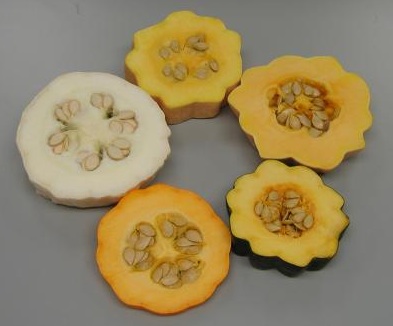
 November 6, 2009,
November 6, 2009,
Gainesville, FL – Researchers in Florida are searching for a cheaper way to
determine carotenoid content of pumpkin and squash.
November 6, 2009,
Gainesville, FL – Carotenoids, the family of yellow to red pigments responsible
for the striking orange hues of pumpkins and the familiar red colour of
vine-ripe tomatoes, play an important role in human health by acting as sources
of provitamin A or as protective antioxidants. Pumpkins and squash, available
in a wide range of white, yellow, and orange colours, are excellent sources of
dietary carotenoids, particularly lutein, alpha-carotene, and beta-carotene.
The colours of these nutritional vegetables are determined by their genetic
makeup — the concentration and type of carotenoids they contain — which are
influenced by both genetic and environmental factors.
 |
|
| A broad range of carotenoid content represents a spectrum of color in winter and summer squash. |
The good news: this wide
range of carotenoids in pumpkins and squash provides fertile ground for genetic
improvement. When breeders have reliable information about carotenoid types and
concentrations, they can work to improve the vegetables' nutritional value and
create new varieties of antioxidant-packed offerings for consumers.
But identifying and
quantifying carotenoids hasn’t been simple; scientists traditionally use a
method called high-performance liquid chromatography, or HPLC. HPLC is highly
sensitive and reproducible, but can be expensive and time-consuming. To
determine if carotenoid content of pumpkin and squash could be accurately
measured using a less-expensive and simpler method, Rachel A. Itle and Eileen
A. Kabelka from the University of Florida’s Horticultural Sciences Department
designed a research study using colourimetric analysis to correlate colour
space values with carotenoid content in pumpkins and squash. The study appeared
in a recent issue of HortScience.
Pumpkins and squash with
white, yellow, and orange flesh colour were grown at multiple locations for the
study. The flesh of each specimen was evaluated using both HPLC and colourimetric
analysis. According to the research, “strong correlations between colourimetric
values and carotenoid content were identified.”
Interestingly, the
researchers found a “nine-fold increase in total carotenoids provided within
orange–red and yellow–orange coloured cultigens versus yellow colored
cultigens.”
The research determined
that colourmetric analysis can aid breeders interested in increasing carotenoid
content in pumpkins and squash. The method “will be successful, easy to
implement, and inexpensive,” said Kabelka.
Print this page